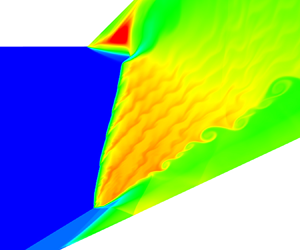Crossref Citations
This article has been cited by the following publications. This list is generated based on data provided by
Crossref.
Wu, Kevin
Zhang, Shu-jie
She, Da-wen
and
Wang, Jian-ping
2021.
Analysis of flow-field characteristics and pressure gain in air-breathing rotating detonation combustor.
Physics of Fluids,
Vol. 33,
Issue. 12,
Zhang, G. Q.
Gao, S. F.
and
Xiang, G. X.
2021.
Study on initiation mode of oblique detonation induced by a finite wedge.
Physics of Fluids,
Vol. 33,
Issue. 1,
Cheng, Lidong
Deng, Xi
Xie, Bin
Jiang, Yi
and
Xiao, Feng
2021.
Low-dissipation BVD schemes for single and multi-phase compressible flows on unstructured grids.
Journal of Computational Physics,
Vol. 428,
Issue. ,
p.
110088.
Dai, Jian
Xu, Fei
Cai, Xiaodong
and
Mahmoudi, Yasser
2021.
Effects of velocity shear layer on detonation propagation in a supersonic expanding combustor.
Physics of Fluids,
Vol. 33,
Issue. 10,
Teng, Honghui
Tian, Cheng
Zhang, Yining
Zhou, Lin
and
Ng, Hoi Dick
2021.
Morphology of oblique detonation waves in a stoichiometric hydrogen–air mixture.
Journal of Fluid Mechanics,
Vol. 913,
Issue. ,
Wang, Aifeng
Shang, Jiahao
Wang, Qiu
and
Wang, Kuanliang
2021.
Effects of Cowl-Induced Expansion on the Wave Complex Induced by Oblique Detonation Wave Reflection.
Processes,
Vol. 9,
Issue. 7,
p.
1215.
Wang, Kuanliang
Yang, Pengfei
and
Teng, Honghui
2021.
Steadiness of wave complex induced by oblique detonation wave reflection before an expansion corner.
Aerospace Science and Technology,
Vol. 112,
Issue. ,
p.
106592.
Yang, Pengfei
Ng, Hoi Dick
and
Teng, Honghui
2021.
Unsteady dynamics of wedge-induced oblique detonations under periodic inflows.
Physics of Fluids,
Vol. 33,
Issue. 1,
Yang, Li
Yue, Lianjie
Yu, Dehai
and
Chen, Zheng
2022.
Numerical study on wave configuration of wedge-induced oblique detonation wave: Reactive boundary layer effect.
Physics of Fluids,
Vol. 34,
Issue. 11,
Ghanbari, Mehdi
Maddah, Soroush
and
Alinejad, Javad
2022.
Influence of coolant multi-jets on heat reduction of nose cone with blunt spike at hypersonic flow.
Scientific Reports,
Vol. 12,
Issue. 1,
TENG, Honghui
ZHANG, Yuhang
YANG, Pengfei
and
JIANG, Zonglin
2022.
Oblique detonation wave triggered by a double wedge in hypersonic flow.
Chinese Journal of Aeronautics,
Vol. 35,
Issue. 4,
p.
176.
Zhang, Le
Khishe, Mohammad
Mohammadi, Mokhtar
and
Mohammed, Adil Hussein
2022.
Environmental economic dispatch optimization using niching penalized chimp algorithm.
Energy,
Vol. 261,
Issue. ,
p.
125259.
Teng, Honghui
Xi, Xuechen
Wang, Kuanliang
and
Yang, Pengfei
2022.
Instability of wave complex resulting from oblique detonation decoupling.
Acta Mechanica Sinica,
Vol. 38,
Issue. 5,
Zhang, Zijian
Liu, Yunfeng
and
Wen, Chihyung
2022.
Mechanisms of the destabilized Mach reflection of inviscid oblique detonation waves before an expansion corner.
Journal of Fluid Mechanics,
Vol. 940,
Issue. ,
Jin, Kaikai
Tai, Yulei
Toghraie, Davood
and
Hekmatifar, Maboud
2022.
The effects of nanoparticle percentages and an external variable magnetic field on the atomic and thermal behaviors in an oscillating heat pipe via molecular dynamics simulation.
Journal of Molecular Liquids,
Vol. 360,
Issue. ,
p.
119570.
Yao, Kepeng
Wang, Chun
and
Jiang, Zonglin
2022.
A numerical study of oblique detonation re-stabilization by expansion waves.
Aerospace Science and Technology,
Vol. 122,
Issue. ,
p.
107409.
Song, Liqian
Wang, Yan
Liu, Dabin
Qian, Hua
Rui, Xiaoting
Shafieezadeh, M. Mehdi
and
Lotfi, Reza
2022.
Evaluation of the Mechanical Failure Criterion to Consider the Triple Base Propellant Safety Life: Application of Sustainable Renewables for Environmental Hazards.
Discrete Dynamics in Nature and Society,
Vol. 2022,
Issue. 1,
Wang, Aifeng
Bian, Jing
and
Teng, Honghui
2022.
Numerical study on initiation of oblique detonation wave by hot jet.
Applied Thermal Engineering,
Vol. 213,
Issue. ,
p.
118679.
Xiang, Gaoxiang
Yichen, Zhang
Qirong, Tu
Haotian, Wei
and
Wang, Qiu
2022.
Study on Initiation Characteristics of Oblique Detonation Induced by Hydrogen Jets in Acetylene-Air Mixtures.
SSRN Electronic Journal,
Shi, Xinxing
Xie, Haopin
Zhou, Lin
and
Zhang, Yining
2022.
A theoretical criterion on the initiation type of oblique detonation waves.
Acta Astronautica,
Vol. 190,
Issue. ,
p.
342.

 $M_0 = 6$ and 7. Thereafter, we introduce a deflected upper confinement, resulting in a new wave configuration. This wave is characterized by a post-turning, triangular recirculation zone coupled with a gaseous wedge connecting the deflection point and ODW surface. A parametric study is performed to analyse the effects of the deflection location, deflection angle and activation energy of the heat release reaction. The results reveal that the wave configuration is due to the evolution of ODW decoupling in an expanded supersonic flow. We further study the surface stability and structural unsteadiness arising for
$M_0 = 6$ and 7. Thereafter, we introduce a deflected upper confinement, resulting in a new wave configuration. This wave is characterized by a post-turning, triangular recirculation zone coupled with a gaseous wedge connecting the deflection point and ODW surface. A parametric study is performed to analyse the effects of the deflection location, deflection angle and activation energy of the heat release reaction. The results reveal that the wave configuration is due to the evolution of ODW decoupling in an expanded supersonic flow. We further study the surface stability and structural unsteadiness arising for  $M_0 = 6$. Upstream-travelling transverse waves are observed for the first time, and effects of different parameters on the surface instability are analysed via fast Fourier transforms. Two destabilizing mechanisms of ODW structures are proposed, one from the post-surface thermal choking and the other from the enhanced surface instability.
$M_0 = 6$. Upstream-travelling transverse waves are observed for the first time, and effects of different parameters on the surface instability are analysed via fast Fourier transforms. Two destabilizing mechanisms of ODW structures are proposed, one from the post-surface thermal choking and the other from the enhanced surface instability.


